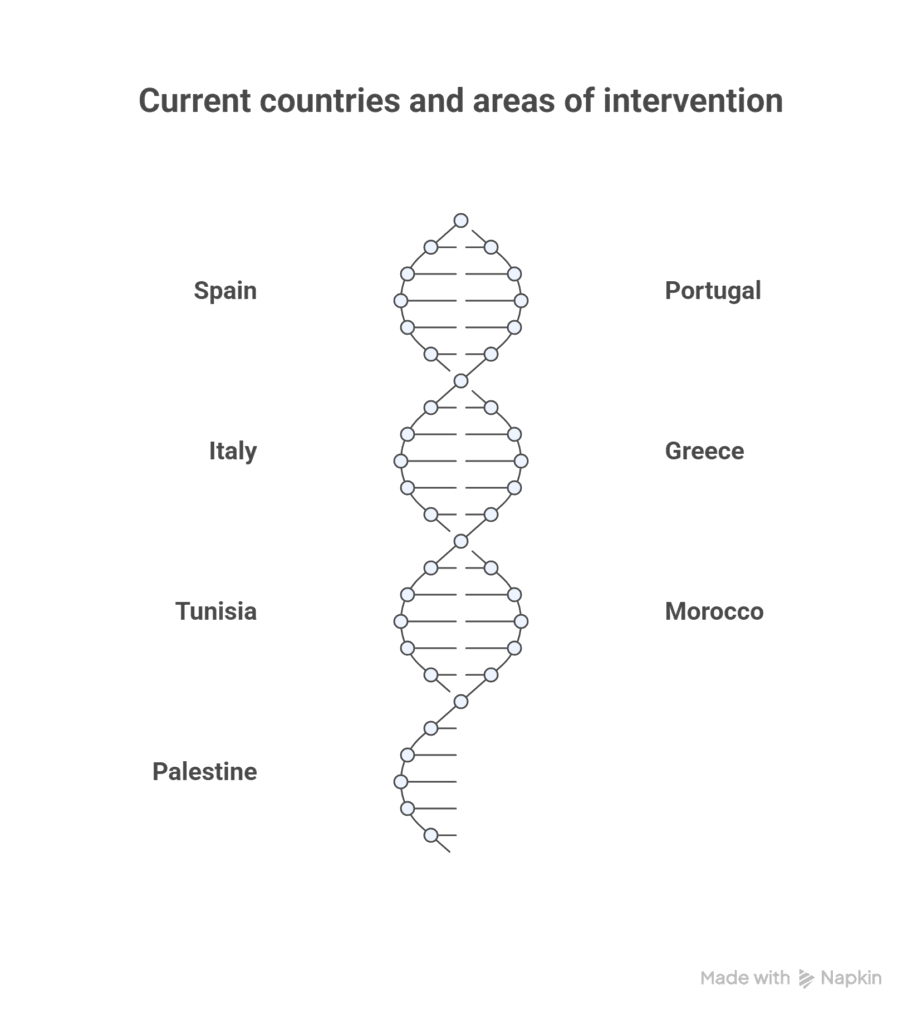COUNTRIES & INTERVENTION AREAS

Situation by country
Far from us the idea of falling into the trap of neo-colonialism or adopting a paternalistic discourse towards these Mediterranean countries. The reality is much simpler and more prosaic: it’s a matter of money, of financial means available to act. The situation of stray animals is hardly any better in northern European countries, proof that it is not a matter of culture or mentality, but of allocated resources.
Ironically, the tourism that enriches these Mediterranean regions often worsens the problem instead of solving it. Tourism revenues are scandalously unevenly distributed: a minority is considerably enriched while the local population only collects meager crumbs. These economic inequalities create a vicious circle where local priorities remain the daily survival, relegating animal welfare to the last rank of concerns.
Our role is not to give lessons, but to put our resources at the service of those who, on the spot, know their terrain and want to act.
Greece
Greece is experiencing a real crisis of stray animals, particularly visible in the tourist islands and in Athens. Dogs and cats thrive in archaeological sites, on beaches and in taverns where tourists and locals feed them. The economic crisis of the 2010s dramatically worsened the situation, with many families having abandoned their animals due to lack of resources. The islands experience a cruel seasonal phenomenon: in winter, once the tourists have left, the animals starve by the hundreds. Although sterilization programmes exist in some municipalities, they remain largely insufficient. Malicious poisoning is common, especially in agricultural areas where stray dogs are seen as a threat to herds.
Italy
The Italian Mezzogiorno has one of the highest rates of stray animals in Western Europe. In Sicily, Calabria, Apulia and Campania, packs of stray dogs prowl on the outskirts of cities and in the countryside, often from abandoned hunting or guard dogs. The cat colonies are monumental in the historic centers and around the fish markets. Despite strict national legislation prohibiting euthanasia of healthy animals, municipal shelters (canili) are overcrowded and underfunded, often functioning as dying houses. The cultural tradition of tolerance towards stray animals paradoxically coexists with a flagrant lack of responsibility on the part of owners. Resources for mass sterilization are sorely lacking.
Morocco
In Morocco, stray dogs and cats constitute a major health and social issue, particularly in medinas and popular neighborhoods. Stray dogs, often feared due to the risk of rabies still present in the country, are subject to massive and brutal killing campaigns conducted by the authorities, usually through poisoning or shooting. Cats are more culturally tolerated but live in deplorable conditions, reproducing without control in the souks and around landfills. Rabat and Marrakech have initiated pilot programs for sterilization and rabies vaccination, but these initiatives remain marginal. The lack of public awareness and the absence of protective legislation create a hostile environment where animal suffering is trivialized.
Palestine
In Palestine, the situation of stray animals is exacerbated by the context of permanent occupation and conflict. Veterinary infrastructures are almost non-existent, particularly in the Gaza Strip where the blockade makes it impossible to import medicines and veterinary equipment. Stray dogs and cats wander among the rubble of bombed areas, without access to food or care. In the West Bank, cat colonies proliferate in refugee camps and crowded cities like Hebron and Nablus. Humanitarian priorities legitimately focus on human populations, leaving the animals in total abandonment. Some small local associations try to act despite the restrictions of movement, the lack of resources and the permanent dangers, but their intervention capacities remain derisory in the face of the magnitude of the tragedy, human and animal.
Portugal
Portugal has a situation similar to that of Spain, with a particular concentration of stray animals in the rural regions of Alentejo and northern Portugal. Abandoned hunting and herding dogs constitute a significant part of the stray population. If Lisbon and Porto have developed municipal sterilization and identification programs, rural areas remain largely neglected. Stray cat colonies are omnipresent in fishing ports and historic districts. Growing tourism has paradoxically worsened the situation, with some visitors feeding animals without contributing to their sterilization, thus encouraging their reproduction. Local associations are severely lacking in funding to meet the needs.
Spain
Spain is facing a chronic problem of animal abandonment, particularly acute after the hunting season and summer periods. Despite recent legislative advances, thousands of greyhounds (galgos) are abandoned or killed each year by hunters, while shelters are overflowing with abandoned animals. Stray cat colonies proliferate in towns and villages, particularly in the south of the country. Although many local associations work bravely with sterilization and adoption programs, the resources remain insufficient given the magnitude of the problem. The culture of sacrificing “unproductive” animals persists in some rural areas, perpetuating a cycle of suffering.
Tunisia
Tunisia is facing a similar problem to other Maghreb countries, with a massive presence of stray animals in towns and villages. Rabies remains endemic, causing panic reactions and violent elimination campaigns of stray dogs. Cats, although better accepted in the local culture, proliferate without control in markets, ports and tourist sites. Veterinary resources are concentrated on farmed animals, leaving pets and strays without access to care. Some courageous Tunisian associations are trying to develop sterilization and awareness programs, but they face a lack of financial resources and disinterest from the authorities. Stray animals are often perceived as a hygiene problem rather than an animal welfare issue.
